Menu
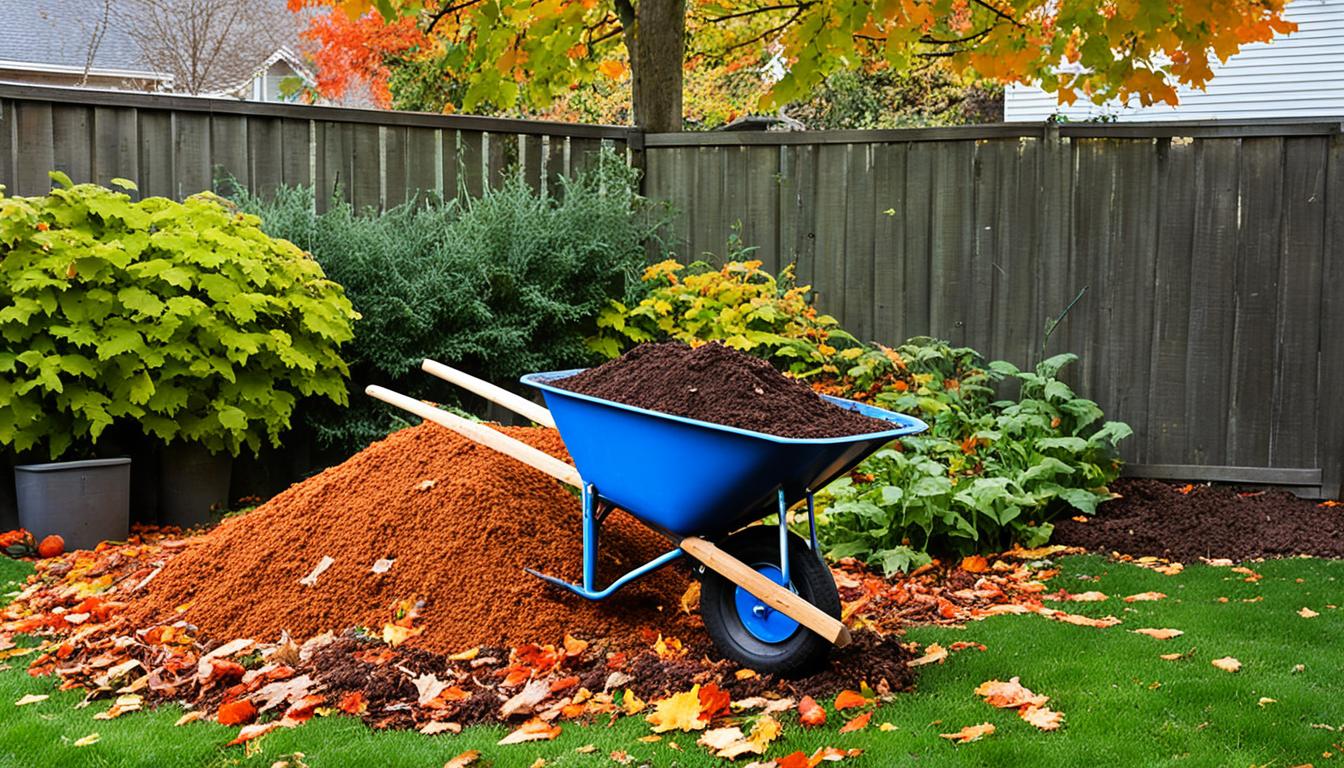
Do you know that late autumn is great for getting your soil ready? This season is perfect for making your garden soil healthy. It’s the best time to add natural stuff like leaves and compost. Soil is not just dirt. It’s full of life. By adding these things, the soil gets better over the cold months.
These materials feed the soil throughout winter. This helps roots grow well and supports tiny life in the soil. Getting your soil ready in autumn stops it from washing away in winter. It also makes sure the soil is perfect for planting in spring.
To check if your soil is good, do a soil test. Many places test soil for free. You might need to change the pH or add nutrients. For example, you might need to add soybean meal. This helps at a rate of 2 pounds per 1,000 square feet.
Methods like No-Dig Gardening or Cover Crop Planting are gentle on the soil. They don’t mess up the soil’s natural structure. Covering the soil with compost or leaves is also great. It keeps the soil healthy and warm. This helps good microorganisms to grow.
The autumn season is perfect for getting your soil ready. It’s when the natural world helps your garden soil the most. We can make our soil better now, so our gardens thrive in the spring. The best timing is late autumn, setting up a great garden for next year.
Getting your soil ready in autumn has many benefits. Soil with lots of organic matter slowly gives out nutrients. This is great for plant roots and other life in the soil. In autumn, we can do things like think about not tilling the soil, or cover the ground with natural materials. These actions keep the soil healthy and ready for planting later on.
Autumn is rich with resources that benefit the soil. Things like leaves, compost, and cover crops help improve soil. The cool autumn weather means these materials break down slowly. This keeps essential nutrients in the soil for the next plants to use.
It’s good to cover the soil in winter. This keeps it healthy and stops weeds. Doing a soil test every few years can show what the soil needs. Results from the test help us add the right nutrients. This way, when spring comes, our soil is perfect for planting.
| Soil Preparation Technique | Benefits |
|---|---|
| Reevaluating tilling practices | Minimises soil disruption |
| Covering with organic materials | Suppresses weeds, prevents erosion |
| Using cover crops | Enriches soil with organic matter |
| Soil testing | Determines nutrient deficiencies and pH levels |
So, autumn is the best time to prepare your soil. Using what nature gives us and good preparation techniques creates a strong base for your garden. This ensures your plants will be healthy and full of life in the future.
In autumn, getting to know the garden soil types is vital. Your garden’s soil could be clay, silt, sand, loam, or peat. Knowing this helps improve soil quality effectively.
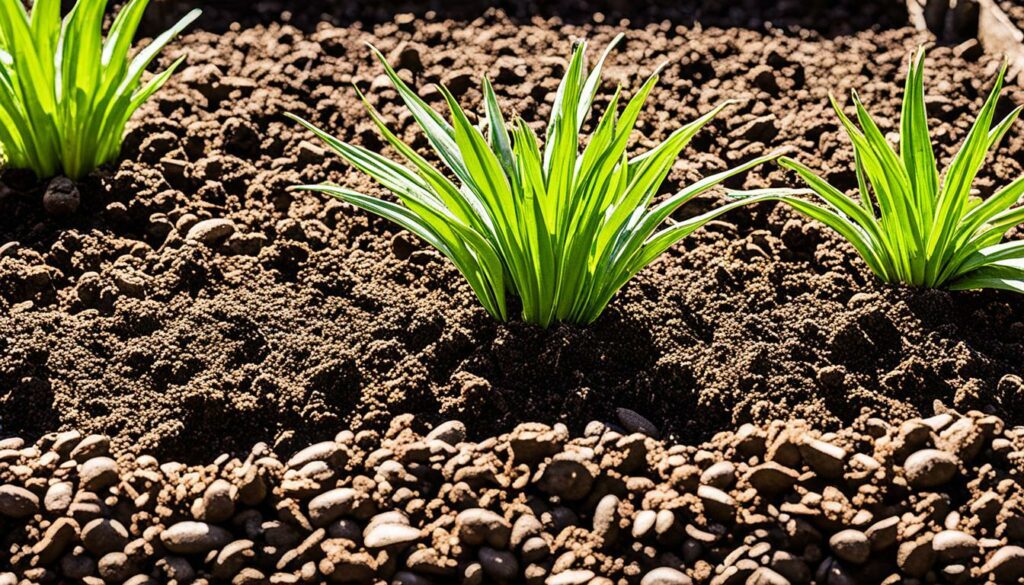
Each garden soil type is different. It affects the way we add soil changes. For example:
It’s key to test soil structure for air, water, and root paths. Start by feeling the texture and testing for main nutrients. This is the first step to better soil quality.
| Soil Type | Characteristics | Recommended Amendments |
|---|---|---|
| Clay | Wet, sticky, poor drainage | Organic matter, gypsum |
| Sandy | Gritty, quick drainage, nutrient leaching | Compost, aged manure |
| Loamy | Balanced texture, excellent drainage and aeration | Regular compost application |
Testing soil properly helps tailor needed changes. This detailed look at your soil allows for the right adjustments. Your garden will then be healthier and more productive.
Testing your soil’s pH is key for better plants. It affects how much nutrients plants can get. Most veggies like soil that’s a bit acidic, between 6.0 and 7.0. Doing pH tests often will help your plants grow strong.
The right pH helps plants take in nutrients. Between 5.5 and 7 is best for them. You should test the soil pH every 3 to 5 years. Or even every year to keep it just right for plant growth.
There are simple ways to test your soil’s pH at home. This can tell you if it’s too acidic or alkaline. You can use pH test strips, electronic meters, or soil test kits. The Jonathan Green kit is a good choice. They give quick results, so you know how to adjust the pH.
County extension offices might give free soil tests. These tests are more detailed than home kits. They check for nutrients like nitrogen and give advice on what your soil needs.
If your soil needs a pH tweak, you can do it yourself. Adding powdered limestone raises the pH for acidic soils. Or adding sulfur lowers it for alkaline soils. You might need to do this a few times to get it right.
Testing soil pH is important for a healthy garden. Knowing and fixing your soil’s acidity lets your plants thrive. It also makes the whole garden ecosystem better.
Autumn is a great time to get your garden soil ready for planting ahead. Using natural soil boosters now improves the soil for the next crops and flowers. This guide focuses on the key natural additives you need for top autumn soil prep.
Adding organic matter to the soil is key in autumn. It helps break down nutrients and makes soil healthier. Using things like kitchen scraps, prunings, leaves, and grass cuttings is perfect for making compost. This mixed compost is great for the soil, helping plants grow strong roots.
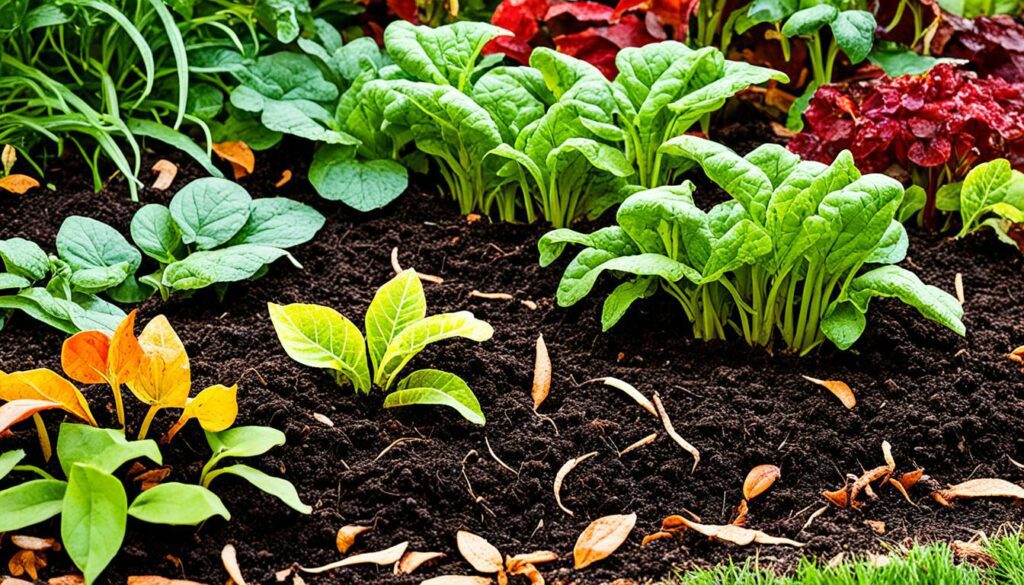
Shredded leaves and wood chips are also top choices for enriching soil naturally. They’re free and boost soil life, holding more moisture.
Manure from a trusted source is important for fall gardening. It’s best when it’s aged about a year. Putting a 1-inch layer on the soil adds loads of nutrients and keeps the soil warm over winter. This keeps earthworms happy and the soil well-aerated and structured.
In short, focusing on compost and aged manure this autumn will set your garden up well. These steps not only strengthen the soil but also fight weeds and stop the soil from being washed away. All this makes sure your garden thrives in the upcoming spring.
Enhancing soil porosity helps create a healthy soil ecosystem. When soil gets too compact, root growth gets limited. Water can’t soak through easily, which hurts the plants. Using good soil aeration methods solves this problem and makes your garden thrive.
Reduced tillage helps keep soil healthy. Too much tilling breaks up the soil and can hurt earthworms. These worms are good for the soil. So, tilling less keeps the soil in good shape and benefits the whole ecosystem. Adding organic matter is another helpful way. Gently mixing in stuff like compost with a fork makes the soil better and healthier.
Mulching after tilling is great for bigger gardens. It helps protect the soil from washing away, keeps it moist, and makes it airy. As the mulch breaks down, it feeds the soil and improves air-flowing spaces.
Plants with deep roots, like radishes, also make the soil breathe better. Their roots make paths through the soil, stopping it from getting hard. This makes it easier for plants to find food and water.
A broad fork is great for tough clay soils. It works the ground gently, letting more air in without a lot of digging. This is super helpful for gardens where you want to disturb the soil as little as possible.
Airing the soil right is key to a good garden. It makes the soil team with helpful bacteria, helps nutrients reach the plants, and lets roots grow deep. Then, the air and water move better in the soil, which is great for everything that grows.
Autumn is perfect for enhancing your garden’s soil health. It’s the best time to add compost and other organic stuff. Composting is great for keeping soil moist, helping good microorganisms grow, and making nutrients flow better. By creating your own compost, you’re choosing a green, cost-effective way to make your garden thrive. This boosts your garden’s energy and the amount of food it produces.
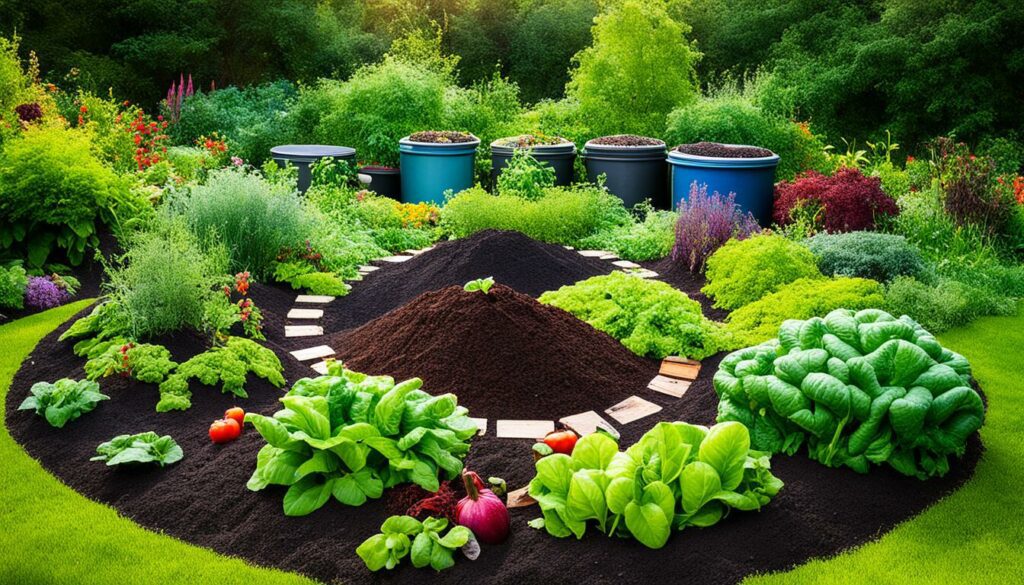
Compost does wonders for soil. Spread a 1-inch layer around your perennials and a 3-inch layer near bushes and trees. This keeps them healthy and fed. It adds key nutrients to the soil which is great for strong plant growth and fighting off diseases.
Using compost made with leaves, wood chips, and worms is brilliant. Mix in worm castings to really boost soil health. Also, adding things like blood meal, crab meal, and alfalfa adds organic nitrogen. This can make your soil even better for plants.
Making homemade compost is easy and pays off. Mix kitchen scraps and grass with shredded leaves and cardboard. Things like pine needles are excellent for plants that love acid, such as blueberries. Keep the compost moist and turn it often to help it break down faster.
For the best compost, add leaves from fruit and certain tree types. This is a great way to recycle kitchen and garden waste. It enriches the soil and helps create a place where plants can really thrive. Your garden will be lusher and more productive thanks to all the nutrients.
| Soil Amendment | Benefits | Application |
|---|---|---|
| Compost | Improves moisture retention, promotes microorganisms, aids nutrient cycling | 1″ layer for plants, 3″ layer for shrubs and trees |
| Shredded Leaves | Adds organic matter, slowly releases nutrients | Mix with green materials in compost |
| Worm Castings | Significantly improves soil health with only 2% by volume | Incorporate into the soil |
| Organic Nitrogen | BOOSTS soil fertility and plant vigor | Add to compost or soil directly |
One key autumn task is applying organic mulch for many garden benefits. For Annapolis, MD, late autumn is best, before winter sets in. Use materials like shredded leaves, straw, or bark at 2-4 inches thick to protect and help soil.
Organic mulch makes soil better over time and keeps it healthy. Always leave a bit of space between mulch and trees for air. This stops problems like mold or pests from growing, as well as too much water getting in.
Gardeners should check the mulch layer each autumn. Adjust its depth as needed based on how wet it gets or how often it freezes. Mulching is very important for keeping soil warm and plants safe from cold, making spring better for plants.
Mulching shields plants in winter and makes the garden lively in spring. It keeps the soil moist and reduces weed growth. Materials like leaves or straw break down, feeding the soil and keeping it healthy. This means less work in pulling out weeds.
In autumn, mulching also keeps the soil warmer longer to help good bugs and worms. Annapolis locals can get great mulching services from places like Paradise Landscapes. They make sure mulch is put on right and cared for.
| Mulching Benefits | Description |
|---|---|
| Soil Protection | Prevents erosion, suppresses weeds, conserves moisture. |
| Fertility Enhancement | Enriches soil with nutrients as mulch decomposes. |
| Regulates Soil Temperature | Protects against freeze-thaw cycles, maintains warmer soil conditions. |
| Pest and Disease Control | Improves airflow, reduces risk of mold and pest infestations. |
Cover crops have been used for over 3,000 years, based on early Chinese books. They help keep the soil fertile and protect it during winter. These crops make the soil better, stop it from washing away, and keep nutrients in the ground.
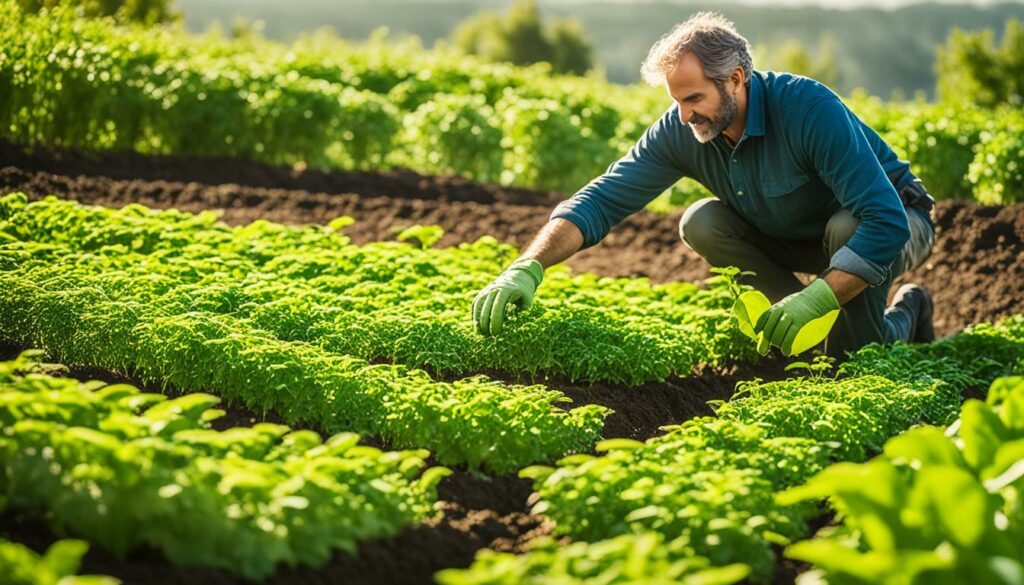
There are three main types of cover crops: grains, legumes, and broadleaves. Grains like winter wheat and rye are tough and great for the soil. For easier options, look at peas from Austria. Legumes, such as peas and clover, add nitrogen to the soil. This makes the ground naturally richer. Broadleaves, like radishes and mustards, help break up hard soil. Red clover is special because you can sow it on ice. It starts to grow when the ground thaws in spring.
Planting cover crops is simple. You can scatter seeds over dug soil and cover them. A test in California found that this makes the soil healthier. Cover crops should be grown after the main harvest. They help the soil over winter. Often, this means more crops later, like soybeans and corn even when there’s not much rain.
A recent survey shows more farmers are using cover crops. They spend between $6 and $25 an acre for seeds. But, most say it’s worth it. Planting cover crops can help control weeds and keep the soil moist. This protects the soil for the long-term.
When the cover crops start to flower, cut them before they make seeds. You can mix the plant bits back into the soil or use them for compost. This adds important material to the soil. Wait a few weeks before planting new crops. This lets the soil absorb the nutrients from the cover crops well.
| Cover Crop Type | Main Benefit | Notable Example |
|---|---|---|
| Grains | Improves soil structure and recycles nutrients | Winter Rye |
| Legumes | Nitrogen fixation | Peas, Red Clover |
| Broadleaves | Breaks up compacted soil | Radishes, Mustards |
Using cover crops in winter is a key to keeping the soil healthy. It’s a must-do for good, earth-friendly gardening. This keeps the soil happy all year round.
No-dig gardening is about not disturbing the soil too much. It keeps the soil’s structure and life intact. This way, you keep your soil’s little workers, like earthworms, happy. This makes the soil stronger, which is good for your plants. Instead of digging, you just layer natural materials on top of the soil. Things like leaves or compost are great. Over time, these materials mix with the soil on their own. This method is great for small spaces or for growing plants in raised beds. It might take a bit of work to start with. You might need to remove some weeds and add a layer of mulch. But, in the long run, it will save you a lot of time and help the environment.
| Item | Cost |
|---|---|
| Garden Plot Rent (20×40 feet) | $80 per year (including free water) |
| Compost | $6.25 per 35 gallons or $25 per cubic yard |
| Shredded Wood Chips | $2.50 per 35 gallons or $10 per cubic yard |
I’ve used no-dig methods to grow over 25 pounds of food by the end of May. This is much easier than traditional digging. It helps the soil and makes my garden a bustling, healthy place with less work.
As we move into autumn, it’s time to care for the soil more. This soil maintenance routine helps get the garden ready for growth. By cleaning up in autumn, we improve the soil naturally. This also makes it a good place to plant in the coming season.
First off, we need to get rid of weeds and summer’s leftovers. This stops unwanted plants from growing out of control next year. It makes soil better by letting it keep more nutrients and water for the right plants.

After cleaning, let’s improve the soil with enriching the soil organically. Adding compost or wood chips is a top choice. Compost can make soil hold water better by up to 40%. It also makes the soil light, which plants love.
Using things like a Demeter 3-Bin Composter helps make soil full of nutrients. Adding crops like field beans and winter rye gives needed nutrients for plants. Covering the soil with compost and organic matter stops weeds, protects the soil, and makes plants healthier over time.
Focusing on soil is key for raised bed autumn preparation. First, clear out old crops. This stops plant diseases and pests from sticking around.
Adding compost or aged manure boosts soil fertility. This is easier in raised beds. It’s vital to keep the soil full of nutrients for plant health.
Using a layer of mulch, like chopped leaves, is also great. It makes soil better, keeps it moist, and protects from winter. For garlic and other delicate plants, straw helps keep the soil warm and pest-free.
As it gets colder, watch out for slugs in the wet. Stopping them early saves your new plants in spring.
Cover crops, like winter rye and clover, are important too. They help with weeds and add goodness to the soil. This means healthier, more productive raised garden beds.
Using sustainable ways in autumn helps the environment and sets your garden for success later. This approach boosts plant strength, cuts down on diseases, and grows more in your garden. Autumn is key for getting your soil ready, which is fundamental for green gardening.
Improving soil health is a top plus for green gardening. I use *earth-friendly ways* like composting and adding organic materials. This feeds the soil, encourages good bugs, and boosts the plants health.
Saving resources is another big win. I collect rain for the plants and pick natural ways to keep bugs away. Adding cover crops in winter helps keep the soil in place and feeds it, making the garden healthier in the long run.
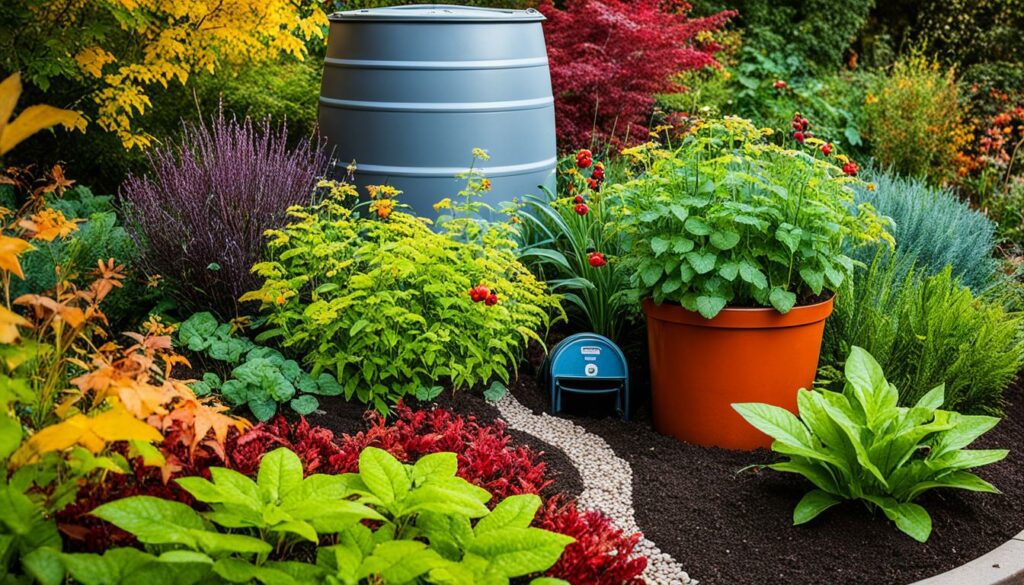
Being green in the garden means smart choices. I avoid digging up the earth which can hurt the soil and helpful worms. I rather cover it with things like compost or leaves to keep the ground healthy and stable.
Testing the soil in autumn is also crucial. It helps me know what the ground needs, like a pH balance or extra fertiliser. Using natural fertilisers keeps the soil rich and supports a varied plant life.
| Method | Benefits |
|---|---|
| Cover Crops | Prevent soil erosion, add organic matter |
| Composting | Enrich soil, promote microbial activity |
| Rainwater Harvesting | Conserve water, reduce carbon footprint |
| Natural Pest Control | Less chemical use, more biodiversity |
Focusing on *autumn garden sustainability* is essential. These steps help build a resilient and fruitful garden. This way, my garden supports nature while preparing for a great season ahead.
Properly managing water in the garden, especially in autumn, is vital. It keeps the soil ready for new planting. Good soil moisture regulation is key to a productive garden. Without it, more than half of the world’s food could be at risk.
Having the right amount of water in the soil is crucial for plant health. Use mulch to keep the water from evaporating too fast. Methods like drip systems and sprinklers target the plant roots directly, reducing water waste. These methods are used on only 18% of farms globally, yet support 40% of our food needs.
In the United States, farms that use irrigation produce significantly more wheat and corn. Groundwater is a cheap source for this, especially as water gets scarce and costlier due to climate change.
Soil compaction is a big issue for managing water in the garden. It stops water from seeping through and restricts root growth. This can hurt the plants. To stop it, don’t work the soil when it’s too wet. Placing walkways can spread out the weight and help.
Not turning the soil (no till) and planting cover crops can really help. They improve the soil’s health and structure. This stops soil compaction and helps water get in better.
In the U.S. Midwest, changing soil moisture causes big economic losses each year. By dealing with compaction, we improve soil health. This makes the garden more productive and cuts losses.
Using smart water methods and stopping soil compaction make gardening better. It saves water and uses our resources well. This is crucial with climate change and other environmental challenges around the corner.
When looking at autumn planting selection, choose plants that grow well in cool weather. Beets, cauliflowers, spinach, and Brussels sprouts are great choices. They grow strong roots before winter.
Spring-blooming bulbs like tulips and hyacinths should be planted in autumn. They need the cold to bloom beautifully in spring. Perennials also do well when planted in autumn, growing strong roots during this season.
If you’re into pretty gardens, pick plants with bright autumn colours. Encore Azaleas and Loropetalum shrubs shine with their autumn blooms and colourful leaves. Camellias, like the ‘October Magic’ series, have lovely, rose-like flowers in various hues.
The right fall gardening varieties boost your garden’s look and help the environment. Pansies and violas adapt well thanks to late summer’s warm soil. Their roots grow strong before it gets too cold.
Buying plants late summer or early fall can save you money on bulbs, perennials, and trees at garden centres. It’s a smart time to invest in a garden that’ll look beautiful and bear fruit well into autumn.
For new trees and shrubs, remember to water them regularly and to lay down mulch. Mulch keeps the soil moist and the right temperature. It also stops weeds, helping your new plants thrive.
As we welcome autumn, it’s a great time to renew our gardens. Choose the ideal autumn plants and enjoy the process of autumn planting.
Starting autumn soil preparation in your garden might seem hard at first. Yet, with the right tools and a clear plan, it’s doable. Beginners can get their gardens ready for the next seasons with these tips and steps.
Autumn preparation needs some key tools. You’ll need:

Follow these simple gardening tips and steps for a good start:
These soil prep techniques set the path for a great garden in spring. They focus on building healthy soil. Healthy soil helps plants grow strong and gives a good harvest.
Being careful in autumn soil preparation can keep your garden healthy. Many people forget to check the soil’s pH level. This is important because soil can be acidic, neutral, or alkaline. Knowing the pH helps choose the right plants and amendments. Soil with a pH of 5 to 7.2 is best for plants. East Texas might be acidic, while Texas and Oklahoma usually have alkaline soil.
Over-tilling is a mistake in fall gardening. Too much tilling damages the soil’s structure. It also harms earthworms that help with drainage and air in the soil. Try not to till a lot. Use a fork to mix in organic matter like compost gently.
Using soil amendments wrongly is also a big mistake. Fresh manure is good for plants but can burn them if used too soon. It needs to age or be composted first. Also, make sure the compost is fully broken down. This prevents it from taking nutrients the plants need to grow.
It’s vital to understand how different soil types affect your garden. Clay, sand, and loam soil types manage moisture and nutrients differently. Using the right practices, like reading and following fertiliser instructions, helps plants get what they need.
Not mulching enough is a common slip-up. Mulching garlic stops weeds and makes maintenance easier. Use at least six inches of mulch around garlic. This will save you from more work later.
By knowing and avoiding these gardening errors, your garden can thrive. Good soil preparation prevents many problems. It makes your garden ready for a successful spring.
Autumn soil prep is key for a colourful, lasting garden. By spending time now, next year’s garden will be better. Mixing in natural materials and checking soil health makes plants grow strong. Not digging and using mulch keep the soil happy.
Tests show soil’s nutrients drop in autumn. It’s best to check soil in spring, too, for exact plant needs. But autumn checks help ready the soil for a good spring start. This way, the soil is perfect when it’s time to plant.
Testing soil every three years is a must to keep the right nutrients. Also, take samples at the same point of each year. This ensures the soil stays fertile. Putting in compost often boosts soil life. This keeps plants healthy, showing no yellow leaves. And it’s important to water and feed them right to fight off pests.
Fall is a great time to prepare the soil. Organic stuff like leaves is easy to find then. Covering the soil with sheets or planting cover crops helps it stay rich and fight off diseases. Doing this means your garden will grow well when spring comes.
Autumn offers natural materials like leaves and composted plants for the soil. These materials break down slowly due to the cooler weather. This way, they release nutrients into the soil over winter. This helps plants grow strong roots and supports healthy soil life.
To find out your soil type, look at its texture and make-up. Soil can be clay, silt, sand, or a mix known as loam. Each kind affects how water and air move in the soil. You can test your soil’s texture easily to see what type it is.
Soil pH affects what nutrients plants can use and how well they grow. Most plants like soils that are a bit acidic. Testing your soil’s pH helps you adjust it as needed. For example, you might add lime or sulphur to make the soil just right for your plants.
For autumn, use compost and aged manure to improve the soil. Compost is made from kitchen waste and garden clippings. It feeds the soil over time. Aged manure, from places you trust, adds nutrients and helps the soil’s structure.
Good soil aeration is key for healthy plants. To improve it, avoid too much digging which can harm the soil. Instead, use a fork to gently mix in compost or other organic matter. This method helps without hurting the soil.
Compost boosts soil health by keeping it moist and full of helpful bacteria. Making your own compost helps recycle kitchen scraps and garden cuttings. This way, you put nutrients back into the soil. This is great for growing strong, healthy plants.
Mulch, like leaves or straw, shields the soil in autumn and winter. It stops soil from washing away, keeps weeds at bay, and holds moisture. Plus, as mulch breaks down, it feeds the soil. This creates a perfect home for helpful soil creatures.
Cover crops like field beans and grasses help protect the soil in winter. They stop nutrients from washing away, keep the soil in place, and make it better for planting. These crops are planted in autumn and turned into the soil in spring.
No-dig gardening leaves the soil’s natural structure and life undisturbed. This helps prevent soil loss and keeps the soil’s tiny creatures happy and at work. Putting organic matter on top of the soil lets nature do the mixing for you.
In autumn, remove weeds and old plants to give room for good soil additions. Covering the soil with compost or wood chips keeps it healthy and moist. These steps keep the soil rich and ready for planting again in spring.
To ready raised beds for autumn, clear out old plants and enrich the soil with compost. Customising your soil mix is easy in raised beds. This preparation ensures your beds are ready to grow healthy plants in spring.
Using eco-friendly ways in the garden helps the environment and your plants. Capturing rainwater, choosing local plants, and managing pests naturally lower your impact on the planet. This makes your garden more resilient and balanced.
To manage water well, use mulch and direct watering to the plants, not everywhere. Avoid walking on wet soil, as this might damage its structure. Pathways can help you move around the garden without causing harm to the soil.
In autumn, plants like beets and spinach do very well. Flowers such as coneflowers add colour to your garden. Picking these plants means a healthier and more beautiful garden.
For beginners, necessary tools include a spade, fork, and compost bin. Testing your soil’s pH and knowing what you need to add are critical steps. Don’t forget to mulch the soil to protect it. These basic steps get your garden ready for the next season.
It’s important not to skip soil pH testing in autumn. Beware of over-tilling, which can harm the soil. Also, make sure to use well-composted organic matter. These steps help avoid problems and set your garden up for success.